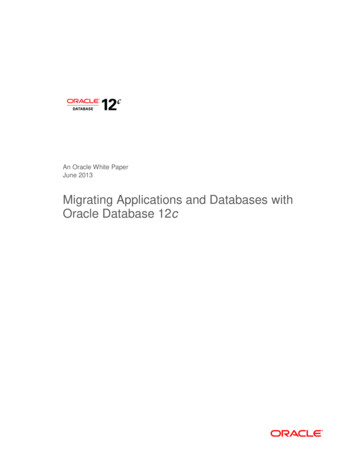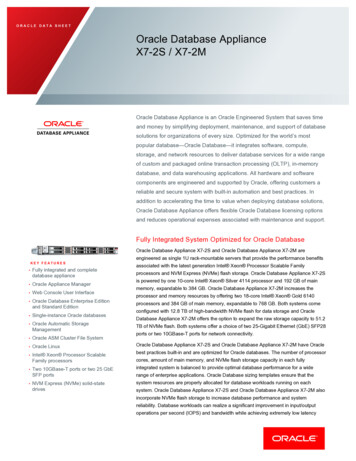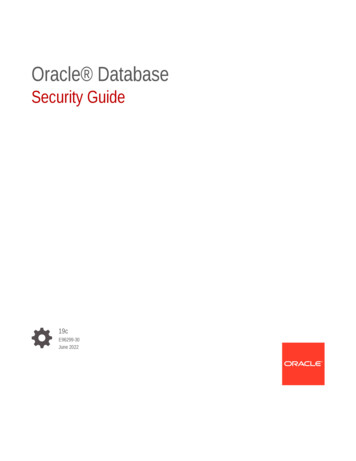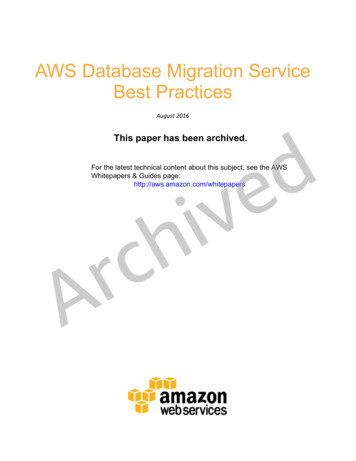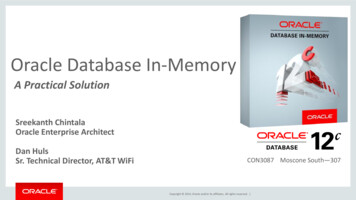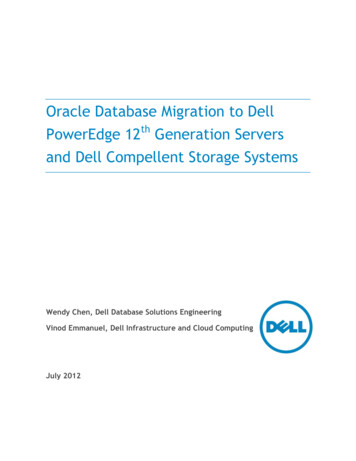
Transcription
Oracle Database Migration to DellPowerEdge 12th Generation Serversand Dell Compellent Storage SystemsWendy Chen, Dell Database Solutions EngineeringVinod Emmanuel, Dell Infrastructure and Cloud ComputingJuly 2012
Oracle Database Migration to Dell PowerEdge 12th Generation Servers and Dell Compellent StorageSystemsThis document is for informational purposes only and may contain typographical errors andtechnical inaccuracies. The content is provided as is, without express or implied warranties of anykind. 2012 Dell Inc. All rights reserved. Dell and its affiliates cannot be responsible for errors or omissionsin typography or photography. Dell, the Dell logo, and PowerEdge are trademarks of Dell Inc. Intel andXeon are registered trademarks of Intel Corporation in the U.S. and other countries. Microsoft,Windows, and Windows Server are either trademarks or registered trademarks of Microsoft Corporationin the United States and/or other countries. Other trademarks and trade names may be used in thisdocument to refer to either the entities claiming the marks and names or their products. Dell disclaimsproprietary interest in the marks and names of others.July 2012 Rev 1.0ii
Oracle Database Migration to Dell PowerEdge 12th Generation Servers and Dell Compellent StorageSystemsContentsExecutive summary . 4Introduction . 5Dell Solutions for Oracle Databases . 5Technology Overview . 5Dell PowerEdge 12th Generation Servers . 5Dell Compellent Storage Systems . 6Oracle Database Migration to Dell PowerEdge 12th Generation Servers and Dell Compellent Storage . 8Test Configuration . 8Migration Options . 9Oracle Automatic Storage Management (ASM) Disk Rebalance . 10Near Zero Downtime Oracle Database Migration to New Infrastructure and Operating Systems . 13Key Benefits of the Migration Solution . 21Dell IT Case Study . 22Summary . 22References . 22TablesTable 1. Hardware and software configurations of the source and the target Oracle systems . 9Table 2. Volume configuration of the source database . 9Table 3. Volume configuration of the target database . 14FiguresFigure 1. Reference configuration of Oracle database migration . 8Figure 2. Oracle ASM disk rebalance to move Oracle database to a different storage system . 11Figure 3. Attach Dell Compellent storage to the source database configuration . 12Figure 4. Detach Dell EMC storage from the source database configuration . 13Figure 5. Create ASM instance without database instance on target systems using DBCA . 15Figure 6. Attach Dell EMC storage to the target database configuration . 16Figure 7. Create a new storage group in Dell EMC storage manager. 17iii
Oracle Database Migration to Dell PowerEdge 12th Generation Servers and Dell Compellent StorageSystemsExecutive summaryDatabase migration has become a routine operation in most IT organizations for modernization,consolidation and platform migration. Migration delivers improved computing power, fasterperformance, new functions, features, and lowered cost of ownership. But this essential operationinvites a lot of risks as well as long operational outages. Migrating Oracle database presents manyunique challenges for IT administrators; such as the complexity, data integrity requirements, and 24x7availability requirements of critical database applications. To address these challenges, Dell offers anear zero downtime migration strategy to move Oracle databases into a new infrastructure with nearzero downtime impact. This methodology has been proven to be reliable and repeatable with theadoption by Dell IT for a large scale Oracle database migration project. This methodology brings outthe best of Dell Compellent storage features like thin provisioning and a well tested referencearchitecture using the latest generation Dell PowerEdge servers.4
Oracle Database Migration to Dell PowerEdge 12th Generation Servers and Dell Compellent StorageSystemsIntroductionThe Dell PowerEdge 12th Generation servers and Dell Compellent storage systems are ideal choices forhosting Oracle database workloads by providing not only superior performance, but also lower TCO interms of manageability, rack space, and power and cooling. For customers who are interested inmoving their existing Oracle databases to new Dell hardware, performing a seamless migration is thefirst challenge they face. In the following sections, this paper examines various Oracle databasemigration options, including the pros and cons of each option. It details a migration solution adoptedby Dell IT that can help customers migrate their existing Oracle databases to the latest releases of Dellhardware with near zero interruption to data availability. A key technology component used in thissolution is the Oracle Automatic Storage Management (ASM) disk rebalance feature. This paperprovides the recommended best practices on how to implement the migration methodology.Dell Solutions for Oracle DatabasesDell solutions for Oracle products are designed to simplify operations, improve usability, and providecost-effective scalability as your needs grow over time. In addition to providing server and storagehardware, Dell solutions for Oracle include: Dell Configurations for Oracle―in-depth testing of Oracle configurations for high-demandsolutions; documentation and tools that help simplify deploymentIntegrated Solution Management―standards-based management of Dell solutions for Oracle thatcan lower operational costs through integrated hardware and software deployment, monitoring,and updatingOracle Licensing—licensing options that can simplify customer purchaseDell Enterprise Support and Infrastructure Services for Oracle―planning, deployment, andmaintenance of Dell solutions for Oracle database toolsFor more information concerning Dell Solutions for Oracle Database, visit www.dell.com/oracle, andthe Dell Oracle Solutions wiki page at http://delltechcenter.com/enterprise.Technology OverviewDell PowerEdge 12th Generation ServersDell PowerEdge 12th Generation servers are the newest addition to the PowerEdge server family. DellPowerEdge 12th Generation servers can help improve the IT experience with the following notablefeatures: Manage anywhere and anytime with agent-free server managementReduce maintenance time with auto-update for replacement partsControl cooling costs with better power monitoring and controlTailor network to applications with fabric flexibilityAccess information quicker via SATA, SAS, SSD and PCI Express Flash drivesData protection using best-in-class RAIDProtect data at rest with malware resistance and faster encryptionKeep data safer with firmware signing and encrypted credentialsAccelerate high-performance computing (HPC) and virtual desktop infrastructure (VDI) throughintegrated graphics processing unit (GPU) technology5
Oracle Database Migration to Dell PowerEdge 12th Generation Servers and Dell Compellent StorageSystems Deliver more throughput with major I/O performance enhancementsBetter application performance with dual internal RAID controller options for PowerEdgeT620 andR720No compromise on performance with greater memory density and capacity along with Intel Xeon E5processorsDell PowerEdge 12th Generation servers feature the Intel Xeon E5-2600 series processors based onthe Sandy Bridge-EP architecture, which deliver more computations per second. Intel Xeon E5-2600series processors provide up to 8 physical cores or 16 logical cores through hyper-threading, and up to20 MB cache. Intel Xeon E5-2600 series processors also include features such as the new Intel advancedvector extensions, and the optimized turbo boost technology.Dell PowerEdge 12th Generation servers include the express flash PCIe solid state drives to deliverbetter internal storage performance by connecting directly to the processor via PCIe bus. These PCIesolid state drives have up to 3x performance of standard SAS SSDs and 1000x performance of 15K SAShard drives.The PowerEdge R720 (12th generation) servers were used in the test configuration for this paper. TheR720 server is a two-socket, 2U rack server emphasizing performance and scalability. R720 servers aredesigned for mid-to-large-size data centers, and are ideal for use as a virtualization or database server.Some highlighted features of the R720 include: Large memory footprint 24 DIMMs (768GB)Dual SD cards for redundant hypervisorCacheCade RAID enhancement to boost I/OInternal storage capacity up to 16 x 2.5 HDD or 8 x 3.5 HDDMaximum of four optional PCIe flash SSD drivesRedundant power supply units (PSU)Hot plug and swappable PSU, HDDs, and fansDell Compellent Storage SystemsThe Dell Compellent Storage Center Storage Area Network (SAN) provides a highly efficient and flexiblefoundation for enterprise and the cloud. Dell Compellent storage features an innovative Dell FluidData architecture to put the right data in the right place at the right time. It enables the storagesystem to dynamically adapt to changes in your business environment.Dell Compellent Storage Center provides a fully virtualized storage platform that includes: Storage virtualization that abstracts and aggregates resources across the array, providing a highperformance pool of shared storageThin provisioning and automated tiered storage to deliver optimum disk utilization and intelligentdata movementSpace-efficient snapshots and thin replication for continuous data protection without wastedcapacityBuilt-in automation and unified storage management to streamline storage provisioning,management, migration, monitoring and reporting6
Oracle Database Migration to Dell PowerEdge 12th Generation Servers and Dell Compellent StorageSystemsReasons Why Customers Migrate to Dell CompellentCompellent has built-in virtualization to simplify management, maximize efficiency, provide flexibilityto adapt to changing requirements, and lower the TCO. Many of these benefits are most noticeable atthe time of a hardware refresh.To eliminate the need for future migration projects, once data is on Compellent it can be migrated toadditional or future hardware incrementally, easily, non-disruptively, without interruption in snapshotand instant restore options, all from within the storage GUI.To eliminate economically disruptive transitions and premature obsolescence, several features arehelpful. Future disk interconnects, as well as SAN interconnects, can be added to existing controllers.The aforementioned incremental migration allows old and new resources to be effectively managedtogether with less hassle and less over-provisioned resources than a single-frame model. Disks can begracefully removed from a virtually-provisioned pool without destroying the pool, so that disk refreshesare easy, routine, and deferred until the disks are too old. In this way older disks can continue todeliver performance benefits competitively even if their capacity is lower than the newer disks.Compellent customers can upgrade the hardware indefinitely simply by replacing the hardware: thesoftware does not have to be re-purchased. This greatly reduces the budgetary hit from an upgrade.To reduce wasteful over-provisioning of capacity, moving to Compellent built-in virtualization enablesthin provisioning without imposing a performance reduction.To use disk performance more efficiently, Compellent’s space-efficient snapshots come without theextra work to move old data out of the way, known as copy-on-write. Compellent has a long history ofhigh customer adoption rates of advanced snapshot technology.To reduce wasteful over provisioning of higher cost, higher performing tiers, Compellent offers tieringbased on historical access patterns so that application performance is more dependable. The tieringuses an appropriate granularity much lower than a GB, reducing over-provisioning, yet large enough toavoid creating a resource penalty at the controller level. The tiering can not only can mix RAID levelsbut shift the RAID levels used within a tier based on the type of data access. Compellent can tierwithin a disk to prevent seek times from growing as much as disks fill up: hot data is moreconcentrated on the disk. With automatic provisioning, the initial setup does not determine the cost ofthe resources that will be consumed. Therefore Compellent provides charge-back reporting so that thedepartments driving the expenses can be charged appropriately, and departments with efficientapplication deployments can benefit from the savings that tiering delivers.Dell has found that a demonstration of how Compellent is set up and managed is typically the tippingpoint that moves people to make a change.Ultimately, the decision to migrate often flows naturally from having seen a Compellentdemonstration.By using Dell to provide the complete data center solution, it becomes easier to make sure thateverything needed to support the application requirements are met.7
Oracle Database Migration to Dell PowerEdge 12th Generation Servers and Dell Compellent StorageSystemsOracle Database Migration to Dell PowerEdge 12th GenerationServers and Dell Compellent StorageTest ConfigurationThe migration methodology provided in this paper is developed based on the reference configurationshown in Figure 1. The Oracle Real Application Cluster (RAC) database is migrated from the sourcesystem to the target system. The reference configuration consists of the following components: Source environment:oTwo Dell PowerEdge 2950 servers running Oracle Enterprise Linux 5 Update 2 (OEL 5.2)x86 64, and Oracle 11g R1 RAC database version 11.1.0.7oRedundant Dell PowerConnect Gigabit Ethernet switches for Oracle cluster interconnectprivate networkoServer-storage interconnect using redundant McData Sphereon 4400 Fibre Channel switchesoDell EMC CX3-80 Fibre Channel storage system where the physical data residesTarget environment:oTwo Dell PowerEdge R720 servers running Oracle Linux 5 Update 7 (OL 5.7) x86 64, andOracle 11g R1 RAC database version 11.1.0.7oRedundant Dell PowerConnect Gigabit Ethernet switches for Oracle cluster interconnectprivate networkoServer-storage interconnect using redundant Brocade 5300 Fibre Channel switchesoDell Compellent Series 40 Fibre Channel storage system where the physical data residesFigure 1. Reference configuration of Oracle database migration8
Oracle Database Migration to Dell PowerEdge 12th Generation Servers and Dell Compellent StorageSystemsTable 1 shows that the target Oracle database environment contains newer releases of both hardwareand software compared to the source environment. The target system consists of not only the latesthardware including servers, storage systems, and SAN switches, but also newer operating systemreleases on the database servers. The Oracle database version remains unchanged on the targetsystem. It is beyond the scope of this paper to discuss the Oracle database upgrade process. You canfind Oracle database upgrade best practices in Oracle documentation.Table 1. Hardware and software configurations of the source and the target Oracle systemsHardwareSource systemDell PowerEdge 2950 serversDell EMC CX3-80 FC storageServerStorageSAN switchSoftwareOS on database serversOracle databaseMcData Sphereon 4400 FCswitchesOEL 5.2 x86 64Oracle RAC 11.1.0.7Target systemDell PowerEdge R720 serversDell Compellent Series 40 FCstorageBrocade 5300 FC switchesOL 5.7 x86 64Oracle RAC 11.1.0.7Table 2 shows the Dell EMC storage volume configuration of the source database.Table 2. Volume configuration of the source databaseUsed forVolumeSizeOracle RACClusterware disks3 volumes of OCRdisks2 volumes ofVoting disks6 volumes for dataarea6 volumes forFlash RecoveryArea (FRA)1 volume for spfileof ASM instanceOracle databaseASM disk name1 GB eachFile systemformatBlock device1 GB eachBlock deviceN/A100 GB eachASM100 GB eachASMdata1; data2;data3; data4;data5; data6fra1; fra2; fra3;fra4; fra5; fra61 GBBlock deviceN/AN/AMigration OptionsThere are many different ways to migrate the Oracle database described in the above referenceconfiguration. Among them, some commonly used technologies are: Oracle Data Pump Export and Import utility is a feature of the Oracle database that enables dataand metadata movement between Oracle databases. This method involves the exporting of thesource database into export dump files, presenting the dump files to the target database, and thenimporting them into the target database. This method can be slow for large systems and can incuran extended downtime during the migration process. Oracle Transportable Tablespace is an Oracle database feature to copy a set of tablespaces fromone database to another. This method involves exporting the metadata, transporting the datafilesfrom the source database to the target database, and then importing the datafiles to the target9
Oracle Database Migration to Dell PowerEdge 12th Generation Servers and Dell Compellent StorageSystemsdatabase. This method is typically faster than the export and import utility by avoiding extractingdata and instead directly integrating datafiles into the target database. However, an extendeddowntime for large databases can still occur. Oracle Golden Gate software provides real-time data replication between Oracle databases.Golden Gate software enables the capability to migrate Oracle database with zero databasedowntime and minimal application switchover downtime. Golden Gate software is licensedseparately from Oracle databases. Compellent Thin Import is an array-based data migration tool provided by the Dell Compellentstorage systems. Thin Import migrates data from external storage systems to thin-provisionedvolumes on the Compellent system. This helps eliminate the allocated but unused space in thesource data, and deliver more usable capacity on the Compellent system. Thin Import is primarilyan offline activity that incurs database downtime.Oracle Automatic Storage Management (ASM) Disk RebalanceOracle ASM is a volume manager and a file system for Oracle database files that supports singleinstance Oracle database and Oracle RAC configurations. Oracle ASM is Oracle’s recommended storagemanagement solution, which provides an alternative to conventional volume managers, file systems,and raw devices. Oracle ASM uses disk groups to store data files. Oracle ASM disk group is a collectionof disks that Oracle ASM manages as a unit. Within a disk group, Oracle ASM exposes a file systeminterface for Oracle database files. The content of files that are stored in a disk group is evenlydistributed to eliminate hot spots and to provide uniform performance across the disks. Theperformance is comparable to the performance of raw devices.Oracle ASM provides the disk rebalance feature where disks can be added or removed from a disk groupwhile a database continues to access files from the disk group. When adding or removing disks from adisk group, Oracle ASM automatically redistributes the file contents and eliminates the need fordowntime when redistributing the content. The adding or removing disks from a disk group can beexecuted using the ALTER DISKGROUP SQL statement within the ASM instance. To control the speedand resource consumption of the rebalance operation, you can include the REBALANCE POWER clausein the ALTER DISKGROUP statement. The REBALANCE POWER clause specifies the degree ofparallelism, and thus the speed of the rebalance operation. It can be set to a value from 0 to 11 forOracle database versions 11.2.0.2 or lower. A value of 0 halts a rebalancing operation. The defaultrebalance power is set by the ASM POWER LIMIT initialization parameter with a default value of 1.The SQL syntax to add disks into a disk group is:alter diskgroup diskgroup nameadd disk ‘disk path’rebalance power n;For example,SQL alter diskgroup dataadd disk '/dev/mapper/data1p1'rebalance power 0;The SQL syntax to drop disks into a disk group is:10
Oracle Database Migration to Dell PowerEdge 12th Generation Servers and Dell Compellent StorageSystemsalter diskgroup diskgroup namedrop disk disk namerebalance power n;For example,SQL alter diskgroup datadrop disk DATA 0006rebalance power 10;A common use case of the Oracle ASM disk rebalance feature is the Oracle database migration to adifferent storage system while the database servers remain unchanged. In the migration scenarioillustrated in Figure 2 below, the source Oracle 11g R1 RAC database runs on two PowerEdge 2950servers, Dell EMC CX3-80 Fibre Channel storage system, and McData Fibre Channel switches. TheDell EMC CX3-80 Fibre Channel storage system is being replaced with the Dell Compellent storagesystem, while other components in the configuration remain unchanged.Figure 2. Oracle ASM disk rebalance to move Oracle database to a different storage systemThe Oracle ASM disk rebalance feature can be effectively utilized for this type of migration scenario.The high level steps for migration are:1. Cable the Dell Compellent storage front-end ports to the McData switches. See Figure 3.11
Oracle Database Migration to Dell PowerEdge 12th Generation Servers and Dell Compellent StorageSystemsFigure 3. Attach Dell Compellent storage to the source database configuration2. Create storage volumes in the Compellent storage for hosting Oracle clusterware OCR and votingdisks, as well as Oracle data files.3. Perform zoning in the McData switches to associate the Dell PowerEdge 2950 servers’ WWN’s withthe Compellent front end ports WWN’s.4. Create volume partitions on the PowerEdge 2950 servers.5. Configure Device Mapper Multipath (DM Multipath) to the volumes on the PowerEdge 2950 servers.6. Stamp the volumes as ASM disks on the PowerEdge 2950 servers.7. Convert the source Dell EMC volumes from using EMC PowerPath to DM Multipath on the PowerEdge2950 servers. This step is necessary to ensure the Dell EMC disks and Compellent disks use unifiedmultipathing software. The Dell Professional Services (DPS) team has developed an automationscript for the conversion of EMC PowerPath to DM Multipath. DPS can be engaged atwww.dell.com/services.8. Move the Oracle RAC Clusterware OCR and voting disks from Dell EMC disks to Compellent disks.The following My Oracle Support (MOS) note at https://support.oracle.com provides detailed stepby- step instructions on how to perform the move; therefore, the steps are not repeated in thispaper.ID 428681.1 – OCR / Vote disk maintenance operations: add / remove / replace / move9. Move the Oracle data files from Dell EMC disks to Compellent disks using Oracle ASM diskrebalance.10. Remove access to Dell EMC disks from the PowerEdge servers.12
Oracle Database Migration to Dell PowerEdge 12th Generation Servers and Dell Compellent StorageSystems11. Remove zoning to Dell EMC disks from the McData switches.12. Detach Dell EMC storage from McData switches. See Figure 4.Figure 4. Detach Dell EMC storage from the source database configurationNear Zero Downtime Oracle Database Migration to New Infrastructure andOperating SystemsAnother use case of the Oracle ASM disk rebalance feature is for the migration scenario depicted inFigure 1. Unlike the migration scenario in Figure 2, the Oracle database is migrated to a completelyseparated infrastructure with newer storage, servers, SAN switches, as well as, a newer release ofoperating systems running on the database servers. The use of Oracle ASM rebalance in this type ofmigration is less familiar to most administrators. The following sections provide a detailed discussionof a near zero downtime migration methodology developed and tested by Dell engineers.Preparing the Target SystemThe target database volumes must be of equal or larger size than the source database volumes. Table3 shows the Compellent volume configurations that are similar to the source database volumes shownin Table 2.NOTE: The ASM disks must be named differently than the source database; otherwise, the ASM diskrebalance will not work in a later step.13
Oracle Database Migration to Dell PowerEdge 12th Generation Servers and Dell Compellent StorageSystemsTable 3. Volume configuration of the target databaseUsed forVolumeSizeOracle RACClusterware disks3 volumes of OCRdisks2 volumes ofVoting disks6 volumes for dataarea6 volumes forFlash RecoveryArea (FRA)1 volume for spfileof ASM instanceOracle databaseASM disk name1 GB eachFile systemformatBlock device1 GB eachBlock deviceN/A100 GB eachASM100 GB eachASMdata7; data8;data9; data10;data11; data12fra7; fra8; fra9;fra10; fra11; fra121 GBBlock deviceN/AN/AThe high level steps to prepare the target system include:1. Create volumes in the Compellent storage and map to the target servers (PowerEdge R720).2. Perform zoning in the Brocade switches to associate the Dell PowerEdge R720 servers’ WWN’s withthe Compellent front-end ports WWN’s.3. Create volume partitions on the two PowerEdge R720 servers.4. Configure DM Multipath to the volumes on the two PowerEdge R720 servers.5. Stamp the volumes as ASM disks on the two PowerEdge R720 servers. Again, ASM disks need tohave different names as the source database or data migration does not work later. The screenoutput of the service oracleasm listdisks command is shown below.# service oracleasm 11FRA12FRA7FRA8FRA96. Install Oracle RAC Clusterware 11.1.0.7 on the two PowerEdge R720 servers.7. Install Oracle Database 11.1.0.7 binary on the two PowerEdge R720 servers.8. Use the Oracle tool Database Configuration Assistant (DBCA) to create the Oracle ASM instancewithout creating the database instance. In Oracle release 11.1.0.7, the creation of the ASMinstance and the creation of the database instance are combined in the DBCA tool. Once ASM14
Oracle Database Migration to Dell PowerEdge 12th Generation Servers and Dell Compellent StorageSystemsinstance has been created in the DBCA Storage Options window, abort DBCA after it reaches theDBCA ASM Disk Groups window so that only the ASM instance is created. The screenshots of DBCAare shown in Figure 5. NOTE: It is not necessary to pre-create any ASM disk groups in the targetsystem.Figure 5. Create ASM instance without database instance on target systems using DBCA9. Set the ASM DISKGROUPS parameter in the ASM instance to include the disk group names of thesource database. For example,SQL ALTER SYSTEM SET asm diskgroups 'DATA','FRA' SCOPE BOTH SID '*';10. Copy the database init.ora files from the source database servers to the target databaseservers under ORACLE HOME/dbs. For example, run the following command from the sourcedatabase servers. scp filename.ora oracle@ target server IP : target serverdestination 15
Oracle Database Migration to Dell PowerEdge 12th Generation Servers and Dell Compellent StorageSystemsEnsure the init.ora file contains the location to the database spfile stored in the ASM diskgroup such as: more initmigrtst1.oraSPFILE ' DATA/migrtst/initmigrtst.ora'11. Shut down the target ASM instances.Presenting Dell EMC Volumes to the Target Database ServersPerform the following steps to present the volumes from the source Dell EMC storage array to thetarget PowerEdge R720 servers:1. Cable the Dell EMC storage front end ports to the Brocade switches in the target system as shownin Figure 6.Figure 6. Attach Dell EMC storage to the target database configuration2. Perform zoning in the Brocade switches to associate the PowerEdge R720 servers’ WWN’s with theDell EMC front end port WWN’s.3. Install EMC NaviAgent client on both PowerEdge R720 servers and start up the NaviAgent client.For example,# rpm -Uvh naviagentcli-6.24.2.5.0-1.noarch.rpm# service naviagent start4. Create a new storage group in the Dell EMC storage manager to include the two PowerEdge R720servers; add the LUNs of the source database into the storage group. Only the 6 volumes of thedata area and the 6 volumes of the FRA area in Table 2 need to be added to the new storage group.In the example below, a new storage group called r720 CX380 includes the two PowerEdge R720servers.16
Oracle Database Migration to Dell PowerEdge 12th Generation Servers and Dell Compellent StorageSystemsFigure 7. Create a new storage group in Dell EMC storage manager5. Reboot target servers to discover the Dell EMC disks.6. Configure DM Multipath for the Dell EMC disks.7. Change ownership of the Dell EMC disks to oracle:dba. For w-rw---brw-rw----1111111111
Oracle Database Migration to Dell PowerEdge 12th Generation Servers and Dell Compellent Storage . 8 . documentation and tools that help simplify deployment . To eliminate the need for future migration projects, once data is on Compellent it can be migrated to additional or future hardware incrementally, easily, non-disruptively, without .



